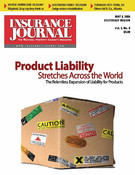As emergency planners and hurricane experts from across the U.S. met in April to plan and prepare for the hurricane season, the timing couldn’t have been better, as massive twisters roared down “tornado alley” through Tennessee, Kentucky and even threatened north Georgia (see page 10). Tornado alley consists of a 1,500-mile north-south corridor which includes North Dakota, South Dakota, Nebraska, Kansas, Oklahoma, Minnesota, Iowa, Illinois, Indiana, Ohio, Missouri, Kentucky, Tennessee, Arkansas, Louisiana and small eastern slices of Wyoming and Colorado.
Claims range from minor damage to complete destruction and death in the aftermath of those tornados. Could this be a premonition of things to come?
Everyone, it appears, was so busy gearing up for hurricanes, they forgot all about other weather-related natural disasters. Of course, with only 22 days until the 2006 hurricane season, everyone should now have made their final preparations.
During the hurricane conference, Max Mayfield, National Hurricane Center director, cautioned everyone, whether or not they are in a hurricane-prone area, to prepare now. Mayfield cited hurricane statistics pointing out that just as many, if not more, hurricane-related deaths occur in the after-effects of the hurricane and nearby, non-coastal areas which encounter heavy rain, flooding and tornadoes.
Mayfield told everyone not to pay so much attention to the black line at the center of the predicted path. He emphasized that, like Hurricane Katrina predictions, estimating how long it will take for a hurricane to strengthen and what path it will take, is a very imprecise art. He cautioned that when the Hurricane Center issues a warning for anywhere on the Southeast coast, everyone should get prepared—including Tennessee, Kentucky, Georgia and North and South Carolina; where the hurricane might not hit directly, but whose residents should be prepared for heavy rain, flooding and possible tornadoes.
Another hurricane expert, Prof. William Gray, echoed Mayfield’s position, even predicting that 17 hurricanes will hit the continental U.S. in 2006.
Independent agents should take steps to prepare their agencies and their policyholders for the upcoming hurricane season, whether we are talking tornadoes or hurricanes. Many of the preparatory steps are actually alike, whether it is a business or a home that is being prepared. Emergency preparation procedures and steps are readily available, but insurance agents should remember to make sure that all their client and policy information can be easily accessed in case the electricity goes out.
To ensure you have power, even if you have a generator, it’s essential to make sure it is in working order. Many agents bought generators last year, but since then have probably forgotten a few essentials, like to change the oil, get it prepared for action by draining out the old gasoline or diesel fuel and replenishing with fresh fuel (yikes, at $3 a gallon) for the upcoming hurricane season.
Many independent insurance agents’ associations encouraged members last year to go with computer data backup systems. Anyone who hasn’t should now—and at the same time, it is a good idea to make sure the systems are all operational, before the first hurricane of the season hits.
It’s not a matter of if a tornado or hurricane will hit, it’s a question of when.
Topics Catastrophe Natural Disasters Agencies Windstorm Hurricane Tennessee Kentucky
Was this article valuable?
Here are more articles you may enjoy.


 Insurers Norfolk & Dedham of Massachusetts and Union Mutual of Vermont to Affiliate
Insurers Norfolk & Dedham of Massachusetts and Union Mutual of Vermont to Affiliate  Carnival Puts Miami Headquarters Up for Sale as Florida Real Estate Soars
Carnival Puts Miami Headquarters Up for Sale as Florida Real Estate Soars  Progressive Records Five-Fold Increase in Q1 Net Income
Progressive Records Five-Fold Increase in Q1 Net Income  Inflation Contributes to Rising Loss Costs for US Commercial P/C Insurers: Fitch
Inflation Contributes to Rising Loss Costs for US Commercial P/C Insurers: Fitch 


